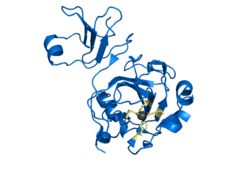Lysostaphin
| Lysostaphin | |||||||||
|---|---|---|---|---|---|---|---|---|---|
 Crystal structure of lysostaphin. Rendered from PDB 1QWY. | |||||||||
| Identifiers | |||||||||
| EC number | 3.4.24.75 | ||||||||
| CAS number | 9011-93-2 | ||||||||
| Databases | |||||||||
| IntEnz | IntEnz view | ||||||||
| BRENDA | BRENDA entry | ||||||||
| ExPASy | NiceZyme view | ||||||||
| KEGG | KEGG entry | ||||||||
| MetaCyc | metabolic pathway | ||||||||
| PRIAM | profile | ||||||||
| PDB structures | RCSB PDB PDBe PDBsum | ||||||||
| |||||||||
Lysostaphin (EC 3.4.24.75, glycyl-glycine endopeptidase) is a Staphylococcus simulans metalloendopeptidase. It can function as an antimicrobial against Staphylococcus aureus.[1]
Lysostaphin is a 27 KDa glycylglycine endopeptidase, an antibacterial enzyme which is capable of cleaving the crosslinking pentaglycin bridges in the cell wall of Staphylococci. Lysostaphin was first isolated from a culture of Staphylococcus simulans by Schindler and Schuhardt in 1964.[2] S. aureus cell walls contain high proportions of pentaglycin, making lysostaphin a highly effective agent against both actively growing and quiescent bacteria.[3]
Staphylococcal infections of both Staphylococcus aureus and Staphylococcus epidermidis continue to be a major issue in clinical settings, particularly those with implantable devices. Staphylococci cause a significant percentage of device infections, and like many other pathogens, rather than living as free planktonic cells within the host they have the ability to form a multilayered community of sessile bacteria cells known as a biofilm on implantable devices. Once a "Staphylococcal" biofilm has formed on an implanted medical device, it is difficult to disrupt due to its antibiotic resistance and protection against bacterial action.
Many studies have been previously published on lysotaphin since its isolation, both in vitro and in vivo. Lysostaphin has been shown to eradicate susceptible S. aureus biofilms. It has also been reported to be effective in disrupting S. epidermidis biofilms in vitro, albeit at higher concentrations of the enzyme.[3] Compared to commonly used antibiotics such as vancomycin, lysotaphin has been shown to demonstrate greater antibacterial activity in vitro.[4] The enzyme has demonstrated effectiveness against methicillin susceptible S. aureus (MSSA) and methicillin resistant S. aureus (MRSA) mediated keratitis in vivo in a rabbit model.[5] Additionally, it has been shown that lysostaphin combined with antimicrobials such as cefazolin, clarithromycin, doxycycline, levofloxacin, linezolid and quinuprisitin/dalfopristin has a synergistic effect for MSSA strains of the bacteria.[6] A study published by Belyansky et al. illustrated that a lysostaphin bound mesh demonstrated dramatic preservation results in a rat model.[7]
Using lyosptaphin to treat "Staphylococcal" biofilm associated infections may prove to be preferable to using antibiotics as it may be possible to administer the enzyme at relatively low doses and disrupt a staphylococcal bioflim, therefore eliminating the need for surgical removal of the infected device.[3]
References
- ↑ Kokai-Kun JF, Walsh SM, Chanturiya T, Mond JJ (2003). "Lysostaphin cream eradicates Staphylococcus aureus nasal colonization in a cotton rat model". Antimicrob. Agents Chemother. 47 (5): 1589–97. doi:10.1128/AAC.47.5.1589-1597.2003. PMC 153340. PMID 12709327.
- ↑ Schindler, C. A.; V.T. Schuhardt (16 January 1964). "Lysostaphin: A New Bacteriolytic Agent for the Staphylococcus". Proceedings of the National Academy of Sciences 51 (3): 414–421. doi:10.1073/pnas.51.3.414.
- ↑ 3.0 3.1 3.2 Wu, Julie A.; Caroline Kusuma, James J. Mond, John F. Kokai-Kun (November 2003). "Lysostaphin Disrupts Staphylococcus aureus and Staphylococcus epidermidis Biofilms on Artificial Surfaces". Antimicrobial Agents and Chemotheraphy 47 (11): 3407–14. doi:10.1128/AAC.47.11.3407-3414.2003. PMC 253758. PMID 14576095.
- ↑ Yang, Xin-Yi; Cong-Ran Li, Ren-Hui Lou, Yue-Ming Wang, Wei-Xin Zhang, Hui-Zhen Chen, Qing-Shan Huang, Yan-Xing Han, Jian-Dong Jiang, Xue-Fu You (January 2007). "In vitro activity of recombinant lysostaphin against Staphylococcus aureus isolates from hospitals in Beijing, Chinga". Journal of Medical Microbiology 56 (1): 71–76. doi:10.1099/jmm.0.46788-0.
- ↑ Dajcs, Joseph J.; Emma B. H. Hume, Judy M. Moreau, Armando R. Caballero, Bennetta M. Cannon, Richard J. O’Callaghan (May 2000). "Lysostaphin Treatment of Methicillin-Resistant Staphylococcus aureus Keratitis in the Rabbit". Investigative Ophthalmology and Visual Science 41 (6): 1432–1437. PMID 10798659.
- ↑ Aguinaga, A; M.L. Francés, J.L. Del Pozoa, M. Alonso, A. Serrera, I. Lasa, J. Leiva (June 2011). "Lysostaphin and clarithromycin: a promising combination for the eradication of Staphylococcus aureus biofilms". International Journal of Antimicrobial Agents 37 (6): 585–587. doi:10.1016/j.ijantimicag.2011.02.009. PMID 21497068.
- ↑ Belyansky, I; V. Tsirline, T.R. Martin, D. Klima, A.E. Lincourt, R. Satishkumar, A. Vertegel, J. Shipp, T.B. Heniford (February 2011). "The Addition Of Lysostaphin Dramatically Improves Survival, Protects Porcine Biomesh From Infection, And Improves Graft Tensile Shear Strength". Journal of Surgical Research 165 (2): 262. doi:10.1016/j.jss.2010.11.587.
External links
- The MEROPS online database for peptidases and their inhibitors: M23.004
- Lysostaphin at the US National Library of Medicine Medical Subject Headings (MeSH)
- EC 3.4.24.75
| |||||||||||||||||